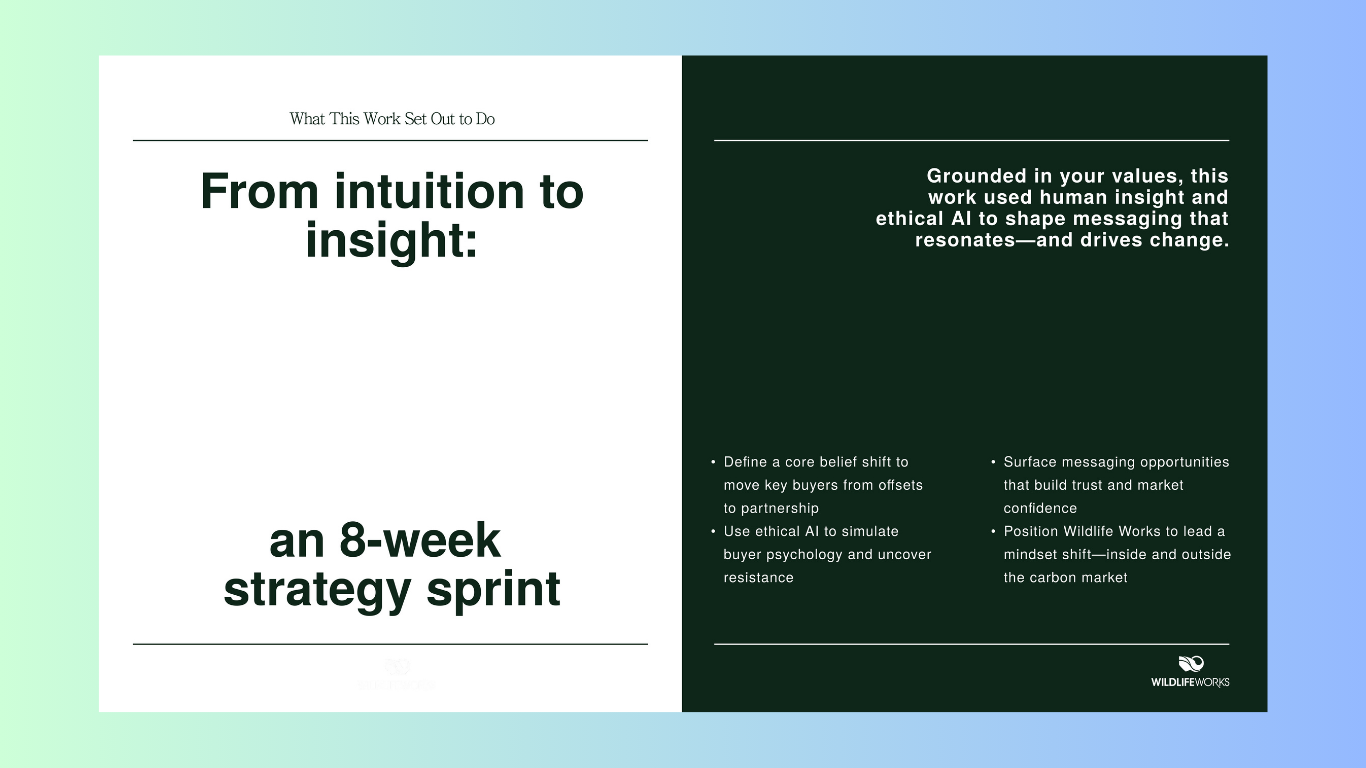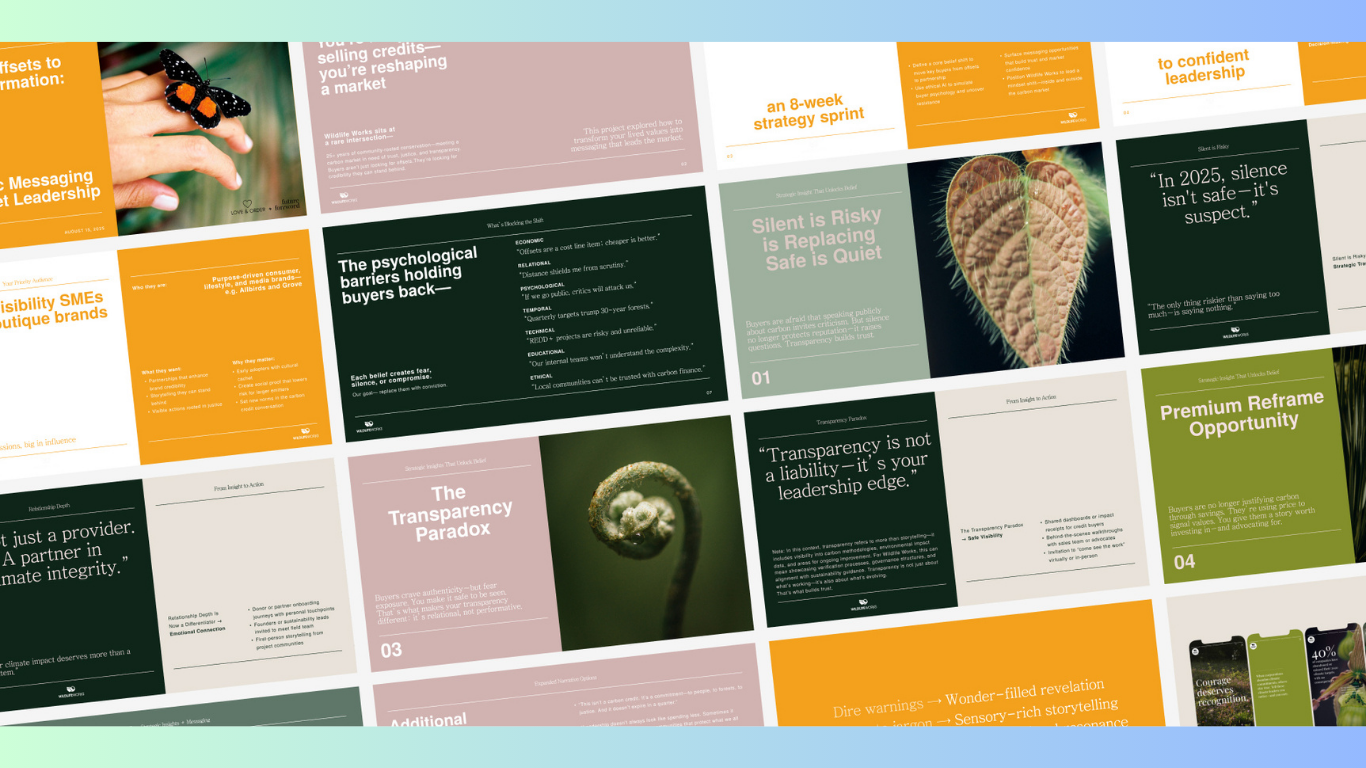Wlidlife Works
Service: Cultural Foresight and Narrative Strategy
Sector: Climate, Conservation, Technology
In collaboration with: Courtney Hardt, Future Foreword
Challenge
In 2025, Wildlife Works stood at a pivotal moment. For nearly three decades, the organization had pioneered community-led conservation across Africa, Asia, and Latin America, protecting more than 1.7 million hectares of forest through REDD plus projects. Its model of conservation with dignity proved that empowering people and protecting wildlife can be one and the same.
But the carbon market around them was shifting. Headlines about greenwashing and volatility had eroded trust. Even credible actors struggled to differentiate themselves in a noisy, skeptical landscape. Wildlife Works wanted to lead a deeper shift, from selling carbon credits as offsets to inviting long term climate partnerships rooted in justice.
To help them do it, they partnered with Love & Order and Future Foreword on a strategy sprint that combined human foresight, behavioral psychology, and ethical AI to uncover what drives belief and trust in the climate economy.
Approach
The engagement began with listening. Through interviews, document reviews, and field stories, the Love & Order and Future Foreword team surfaced the implicit wisdom already guiding Wildlife Works voice.
The discovery revealed a powerful truth. Language reflects worldview. It can replicate harm or repair it. Across teams, staff instinctively avoided extractive phrasing like training communities or delivering aid, and instead described mutual learning and investing in leadership. That linguistic precision reflected the organization’s moral architecture and became the foundation for the next step, identifying a single belief shift that could carry that integrity into the marketplace.
From: Buying carbon credits as a transactional offset
To: Engaging in long term partnerships that restore ecosystems and justice
Over eight weeks, the team combined strategic foresight with ethical AI testing. More than 350 prompts were run through multiple models, including ChatGPT, Claude, and Notebook LLM. Human insight framed every question and filtered every result. AI did not write the story. It illuminated it.
The process surfaced six behavioral barriers behind buyer hesitation, including fear of criticism, moral uncertainty, and emotional distance. By clarifying these patterns, the teams designed narratives that translated integrity into influence.
Outcome
The sprint produced four strategic insights that now anchor Wildlife Works communications strategy:
Silent is Risky: In a market ruled by fear of backlash, silence no longer signals safety. Speaking with transparency builds trust.
Relationship Depth as Differentiator: Buyers are fatigued by intermediaries. Human connection is now a brand advantage.
The Transparency Paradox: Authenticity is craved yet feared. Wildlife Works makes it safe to be seen. Its transparency is relational, not performative.
The Premium Reframe: Price can signal integrity rather than guilt. The real value lies in credible partnerships that restore ecosystems and justice.
Each insight transformed a market tension into a storytelling opportunity and reaffirmed that Wildlife Works did not need new values. It needed language that named the values it already lived.
The strategy reframed Wildlife Works market position from defensive credibility to confident leadership, from offset provider to trusted climate integrity partner, and aligned internal teams across communications, investor relations, and brand storytelling.
Wildlife Works now holds a validated mindset shift that moves buyers from transactions to partnerships. Its team has four strategic insights that unlock behavior at key decision points and message variants designed to shift beliefs, not just communicate features. The organization has claimed a new narrative territory that positions it as a market leader rather than a participant, and a replicable model that other conservation organizations can use to pursue partnership-based approaches. Most importantly, Wildlife Works now has language that makes a different kind of carbon market imaginable and inevitable.
Reflection
The Wildlife Works collaboration showed how interdisciplinary foresight can rebuild credibility in complex markets. By combining the behavioral and AI work of Future Foreword with Love & Order’s cultural foresight and narrative design, the project treated language as infrastructure, the connective tissue between belief and behavior.
It demonstrated that trust is not a communications outcome but a design principle, the alignment of words, actions, and worldview. What emerged was more than a messaging strategy. It was a shift in moral imagination, proving that when organizations speak from integrity, they make new systems of value possible.
For Wildlife Works, this work clarified how to lead with courage in a skeptical market. For Love & Order and Future Foreword, it confirmed the value of designing for trust from the inside out.



